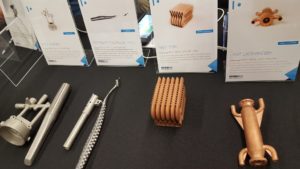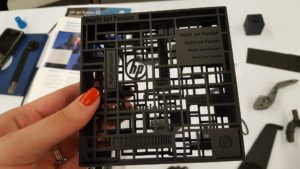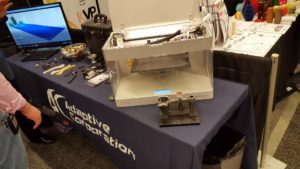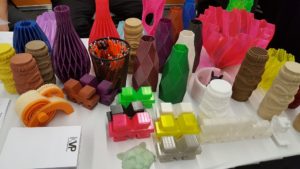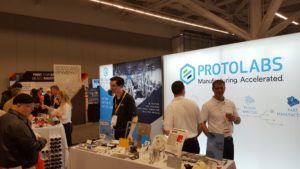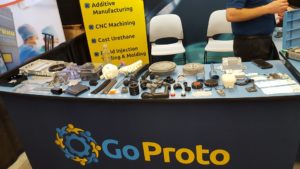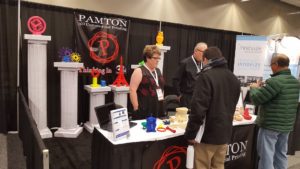
Cleveland art across from the Convention Center… and a reminder that design complexities with AM are free (ish).
This week in Cleveland, the Advanced Design & Manufacturing Expo (ADM Expo) showcased the technologies and companies behind production as industry moves forward. Cleveland, at the heart of the Tech Belt, played host to organizations across five distinct expo zones as more than 2,600 profesisonals came together to explore and discuss in the Design and Manufacturing, Automation Technology, Medical Design and Manufacturing, PLASTEC, and Pack Expos. The two-day event drew crowds to an intriguing agenda of speakers, including a new focus this year on 3D printing and smart manufacturing.
“3D printing innovations and the smart manufacturing revolution are driving the industry’s future, delivering faster prototyping, smarter factories, and lower manufacturing costs. ADM Expo in Cleveland is making these game-changing developments an event focus in 2018,” the conference site notes.
During my day at ADM Expo Cleveland, I enjoyed the opportunity to catch up with familiar companies, meet new suppliers, and hear from an interesting variety of speakers sharing thoughts on additive manufacturing in aerospace, business dynamics, next-generation materials, and when and why 3D printing is and is not appropriate for given applications.
A panel called “Capitalizing on the Changing Dynamics of 3D Printing,” moderated by Jack Heslin, President of 3D Tech Talks and VP of Business Development at Lazarus 3D, touched on the business aspects of additive manufacturing as it impacts manufacturing. Dr. Tracy Albers, President and CTO of rp+m; Mark Horner, VP of Business Development, The Technology House; and Dave Pierson, Senior Design Engineer, MAGNET, shared their insights into the applicability of additive manufacturing.
“You have to think about the physics,” Dr. Albers noted during the session. “You can do a lot with these machines, but you can’t change physics.”
This pragmatic take on 3D printing echoed throughout the session, as all three panelists focused on what can be made possible through design for additive manufacturing (DfAM) — as well as what simply isn’t feasible with this technology. As Heslin noted:
“3D printing doesn’t apply to everything. The economics don’t always make sense — sometimes they’re a disaster.”
 Horner and Pierson added their perspectives as well, touching on the importance of training; the kids growing up today with this technology in their middle school will be the engineers of tomorrow operating this equipment. This focus on experience and learning carried on throughout the day. The second session, “Additive Manufacturing for High Reliability Aerospace Applications,” presented by Dr. James P. Nokes, Prinicpal Director of the Space Materials Lab at The Aerospace Corporation, introduced another important theme in adoption: regulations. There are, he pointed out, still gaps in defect knowledge that are critical blanks to fill when looking at exacting applications in aerospace. The work will be well worth it, as this industry is an especially good fit for additive manufacturing.
Horner and Pierson added their perspectives as well, touching on the importance of training; the kids growing up today with this technology in their middle school will be the engineers of tomorrow operating this equipment. This focus on experience and learning carried on throughout the day. The second session, “Additive Manufacturing for High Reliability Aerospace Applications,” presented by Dr. James P. Nokes, Prinicpal Director of the Space Materials Lab at The Aerospace Corporation, introduced another important theme in adoption: regulations. There are, he pointed out, still gaps in defect knowledge that are critical blanks to fill when looking at exacting applications in aerospace. The work will be well worth it, as this industry is an especially good fit for additive manufacturing.
“When we talk about benefits of 3D printing for aerospace, for the space industry, these are huge. We make tens of parts, not thousands, which fits right in with AM. The fact is, AM is here,” he explained.
“The future of AM is — it’s here. It’s in parts orbiting Juno now, it’s with SpaceX, with Launch Alliance. AM is very detail-oriented, and there is a growing understanding of real requirements. We are focused on developing a fundamental understanding of the specific AM processes, and have an emphasis on using different machines with agnostic builds. It’s the R&D that’s going to be the key.”
A big part of that research will always come back to understanding when 3D printing is the best-suited technology for a particular application. Taking on this issue was a session from Protolabs, which last year at ADM Expo Cleveland introduced PolyJet 3D printing to its portfolio. This year, the company was looking toward metal with Applications Engineer Thomas Davis and Enginering Manager Jim Worth answering the quesion “Is 3D printing the right process for your metal parts? It depends.”
Davis laid out a look at direct metal laser sintering (DMLS) technology as applied to design considerations. While DMLS may be ideal for lightweighting, it is not alone in its ability to create complex organic features, where machining, sheet metal, and casting are also potentially applicable technologies. DMLS also performs well in creation of internal features — but so does casting — and in precision, where machining also shines. When it comes to looking at costs, DMLS often isn’t the most cost-effective technology today, as machining, sheet metal, and casting all offer results at lower price points; similarly, looking at surface finish, DMLS may not be the best bet, and in speed the technology still lags machining and sheet metal. For component reduction, however, DMLS truly takes the spotlight. Protolabs is currently making 99% dense parts through metal 3D printing, and working on components in aerospace and medical device applications, as well as functional prototyping for automotive development.
“3D printing is not a replacement; it’s simply another tool the engineer can choose from,” Davis underscored.
 Further examining the applications for 3D printing and where the technology might fit into production flow was a session titled “Next-Generation Materials for 3D Printing,” as The Technology House’s Horner came back to the mic to share information highlighting Carbon‘s many material offerings.
Further examining the applications for 3D printing and where the technology might fit into production flow was a session titled “Next-Generation Materials for 3D Printing,” as The Technology House’s Horner came back to the mic to share information highlighting Carbon‘s many material offerings.
“Looking at production printing, it won’t make sense for everything — but materials that can stand up to that make more [applications] possible, like with this lattice,” he explained, using the example of the partially 3D printed Futurecraft 4D shoe from adidas, set to be produced at scale.
“In 1987, production tooling was a holy grail; production parts have been a holy grail people have been chasing for a long time. Twenty or thirty years ago, you could design for additive, but if you couldn’t print for production, well… Big strides have been made possible with rapid prototyping, but printing for production is really opening new doors.”
Using additional case studies of customer pain points addressed with Carbon’s high-speed 3D printing technology, Horner showcased a variety of applications where additive manufacturing fit into production workflows with real-world solutions. A major case study announced the day of his presentation, which we will be sharing more information on soon, saw TTH and Carbon work with Vitamix to create a new rinsing nozzle for commercial units. Using less material, lowering costs, and taking a six-part nozzle assembly into a single component, the redesign made possible via additive manufacturing is the latest high-profile collaborative solution from Carbon. Dana McCalllum, Head of Production Partnerships at Carbon, was on-site in Cleveland as well to note the company’s perspectives on the project, telling me that it had been a project the team were really excited about being part of. Horner’s presentation was informative, and McCallulm’s insights helpful, but for me the highlight of the materials session was overhearing another attendee seated behind me whisper to a colleague, “That’s crazy!” during a video quickly introducing Carbon’s 3D printing technology.
Away from the conference sessions, more than 150 exhibitors discussed production technologies at their booths on a crowded expo floor.

At the HP booth, NovaStar Solutions’ Additive Manufacturing Specialist David E. Smith highlighted the possibilities brought about via post-processing for MJF 3D printed parts.
Several familiar faces and names came together, and 3D printing had a small-but-mighty section of the show floor to gather the technology in a showcase. ADM Expo, while enlarging its focus on 3D printing for 2018, drew crowds from a broad cross-section of manufacturing industry participants, and so some of the conversations included an introduction to additive manufacturing (“That’s crazy!”). A pasta company owner, for example, approached a desktop 3D printing booth to ask how he might be able to bring additive manufacturing into ravioli production; another individual was curious about the use of 3D printing in glove production.
With technologies and sample parts on display from Ultimaker (with DesignBox3D), Stratasys Direct Manufacturing, HP Inc. (with NovaStar Solutions), Desktop Metal (with Fisher Unitech), Markforged (with Adaptive), and more, interested parties had their pick of materials (including from Keene Village Plastics) and technologies to learn about.
As 3D printing continues to make its way into industry, overcoming hype and misapprehensions about what is and is not possible with today’s technologies, events such as ADM Expo that roll additive manufacturing into a broader agenda of production will continue to provide an invaluable resource.
Industry-specific events — such as the upcoming RAPID + TCT — will continue to play a critical role in furthering the 3D printing industry, while those with a larger focus throughout manufacturing itself will remain vital in bringing 3D printing into the fold. As was underscored throughout the two-day agenda at ADM Expo Cleveland this year, additive manufacturing is a reality today and will only rise in use — but its largest value comes through understanding it as a complementary tool in the manufacturing toolbox.
Discuss advanced manufacturing and design and other 3D printing topics at 3DPrintBoard.com or share your thoughts in the Facebook comments below.
[All photos: Sarah Goehrke]
Subscribe to Our Email Newsletter
Stay up-to-date on all the latest news from the 3D printing industry and receive information and offers from third party vendors.
Print Services
Upload your 3D Models and get them printed quickly and efficiently.
You May Also Like
Reinventing Reindustrialization: Why NAVWAR Project Manager Spencer Koroly Invented a Made-in-America 3D Printer
It has become virtually impossible to regularly follow additive manufacturing (AM) industry news and not stumble across the term “defense industrial base” (DIB), a concept encompassing all the many diverse...
Inside The Barnes Global Advisors’ Vision for a Stronger AM Ecosystem
As additive manufacturing (AM) continues to revolutionize the industrial landscape, Pittsburgh-based consultancy The Barnes Global Advisors (TBGA) is helping shape what that future looks like. As the largest independent AM...
Ruggedized: How USMC Innovation Officer Matt Pine Navigates 3D Printing in the Military
Disclaimer: Matt Pine’s views are not the views of the Department of Defense nor the U.S. Marine Corps Throughout this decade thus far, the military’s adoption of additive manufacturing (AM)...
U.S. Congress Calls Out 3D Printing in Proposal for Commercial Reserve Manufacturing Network
Last week, the U.S. House of Representatives’ Appropriations Committee moved the FY 2026 defense bill forward to the House floor. Included in the legislation is a $131 million proposal for...





